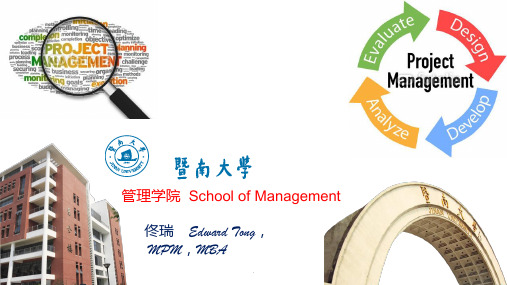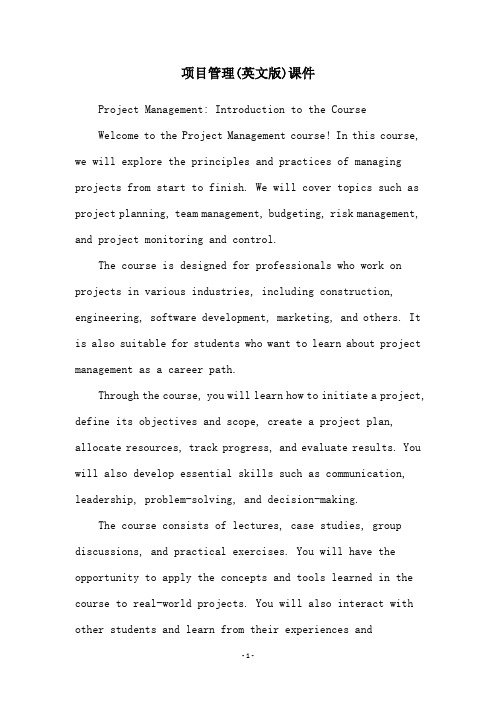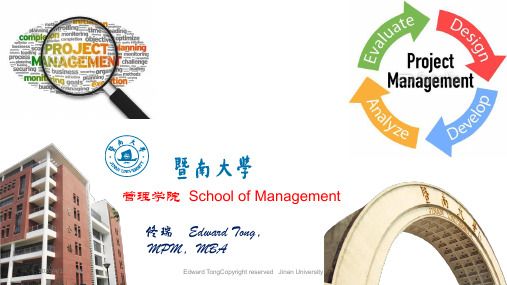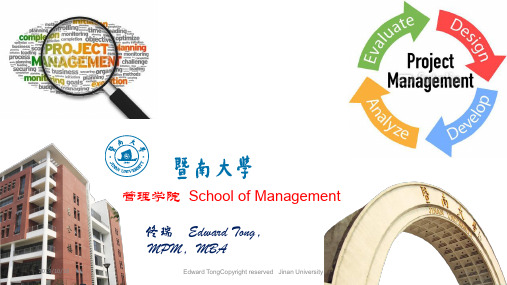暨南大学《项目管理》chapter 13 progress and performance meas
暨南大学《项目管理》chapter 12 outsourcing managing interorg

FIGURE 12.1
.
5
Outsourcing Project Work
• Advantages
• Cost reduction • Faster project completion • High level of expertise • Flexibility
• Disadvantages
• Coordination breakdowns • Loss of control • Interpersonal conflict • Security issues
.
6
Best Practices in Outsourcing Project Work
• Well-defined requirements and procedures. • Extensive training and team-building activities. • Well-established conflict management processes in place. • Frequent review and status updates. • Co-location when needed. • Fair and incentive-laden contracts. • Long-term outsourcing relationships.
FIGURE 12.2
.
7
Key Differences Between Partnering and Traditional Approaches to Managing Contracted Relationships
Partnering Relationships
Traditional Practices
暨南大学《项目管理》chapter 14 project closure

Individual Performance Assessment
• Multirater appraisal (“360-degree feedback)
• Involves soliciting feedback concerning team members’ performance from all of the people that their work affects. • Project managers, area managers, peers, subordinates, and customers.
beinessment of how well the project team is functioning well and if its is
appropriately staffed. • A check on external factors that might change
14–12
Sample Team Evaluation and Feedback Survey
TABLE 14.2
14–13
Project Performance Evaluation: Individual
• Performance Assessment Responsibilities:
• Functional organization or functional matrix: the individual’s area manager.
14–16
Retrospectives
• Lessons Learned
• An analysis carried out during and shortly after the project life cycle to capture positive and negative project learning—“what worked and what didn’t?”
项目管理课程英文课件

4
Chapter 1 – Introduction
3. The importance of learning MPM
• All things start with project and then may or may not transit into operations.
• The project become the great means for a company to make profit in the knowledge economy since all innovations are realized through projects.
construction and engineering projects.
• Become a discipline of Management
– Operation or routine management – Project and program management
2021/3/27
CHENLI
Association, before called Internet.
2021/3/27
CHENLI Modern Project Management • There are two characteristics for MPM
– Enlarged management area-from 3 to 9 areas – Expended to all projects not only the
create a unique product or service • Has a definite beginning and end and
interrelated activities • Under the restriction of resources • For some purpose of a organization or even a
项目管理课件教材(Program Management)

§ 糟糕的会议
• 漫无边际 • 好像没有目的 • 没有日程暨无法了解是否取得进展 • 感觉根本不必参加 • 一言堂
会议(2)
§ 如果被邀请参加一个会议,你应了 解
• 会议目的是什么? • 需要做什么准备? • 你为什么要去? • 会议会持续多久? • 谁是主持人?
内容 § 确定优先级,合理分配时间
有效管理你的时间 (2)
§ 每天早晨做一个当天时间 安排
§ 工作的分类
A. 今天必须作的事情 B. 今天最好能做 C. 今天不能做
a. 顺延 b. 变通方案 c. 从工 作列表中删除
D. 安排别人去做(Delegate)
§ 先做 D, 然后陆续作 A § 可能在午饭后或更早一点
让人们了解项目进展状态(1)
§ 老板、员工及客户需要定期了解 § 员工了解进度、增加参与意识与成就感 § 部门之间增强协调性 § 进度报告 § 会议(Review meetings) § 消息过滤但不能掩盖事实
让人们了解项目进展状态(2)
§ 进度报告(Progress report)
• 已经完成的和下面将做的 • 依据何种事实进行确定与分析 • 是否按计划进行
§ 系列工作列表(清晰、时间顺序) § 经费、人员及时间的规划
• 设备、产品、资源、服务等 • 技术的需求(招人、培训等) • 清晰的开发阶段 (milestones) • 清晰列出假设(assumptions)、依靠(dependency). • 清晰列出责任分布 • 清晰列出风险及应急方案
特性规格说明书 Spec
§ 需求(Requirements) What functionality must it have before it is released?
项目管理(英文版)课件

项目管理(英文版)课件Project Management: Introduction to the CourseWelcome to the Project Management course! In this course, we will explore the principles and practices of managing projects from start to finish. We will cover topics such as project planning, team management, budgeting, risk management, and project monitoring and control.The course is designed for professionals who work on projects in various industries, including construction, engineering, software development, marketing, and others. It is also suitable for students who want to learn about project management as a career path.Through the course, you will learn how to initiate a project, define its objectives and scope, create a project plan, allocate resources, track progress, and evaluate results. You will also develop essential skills such as communication, leadership, problem-solving, and decision-making.The course consists of lectures, case studies, group discussions, and practical exercises. You will have the opportunity to apply the concepts and tools learned in the course to real-world projects. You will also interact with other students and learn from their experiences andperspectives.By the end of the course, you will be able to:- Understand the project management framework and terminology- Define project objectives, scope, and deliverables- Develop a project plan and schedule using appropriate tools- Estimate project costs and allocate resources- Identify and manage project risks- Communicate effectively with stakeholders- Lead and motivate project teams- Monitor project progress and control deviations from the plan- Evaluate project success and lessons learnedWe hope you will find the course informative, engaging, and useful in your professional and personal development. Let's get started!。
暨南大学项目管理-chapter 4 define the project

4–16
FIGURE 4.3
How WBS Helps the Project Manager
• WBS • Facilitates evaluation of cost, time, and technical performance of the organization on a project. • Provides management with information appropriate to each organizational level. • Helps in the development of the organization breakdown structure (OBS). which assigns project responsibilities to organizational units and individuals • Helps manage plan, schedule, and budget. • Defines communication channels and assists in coordinating the various project elements.
• Purpose of the Scope Statement • To clearly define the deliverable(s) for the end user. • To focus the project on successful completion of its goals. • To be used by the project owner and participants as a planning tool and for measuring project success.
暨南大学项目管理-chapter 3 organization structure and culture精品教育文档

3–6
Struggles between project and ongoing operations
2019/10/18
Edward TongCopyright reserved Jinan University
4
What is a good project management system?
•A project management system provides a framework for launching and implementing project activities within a parent organization.
3–3
Once top management approves a project? How will the project be implemented
•Both the project management structure and the culture of the organization constitute major elements of the environment in which projects are implemented.
How much money is available to do the task?
ቤተ መጻሕፍቲ ባይዱ
Why will the task be done?
暨南大学《项目管理》chapter 17 an introduction to agile project management

• Re-evaluates priorities after each iteration (sprint) to produce fully functional features.
TABLE 17.1
17–5
Project Uncertainty
FIGURE 17.1
17–6
Agile Project Management
• Agile PM
• Is related to the rolling wave planning and scheduling project methodology.
Traditional
Design up front Fixed scope Deliverables Freeze design as early as possible Low uncertainty Avoid change Low customer interaction Conventional project teams
2019/11/27
Edward Tong@Copyright reserved Jinan University
22
2.
Once the project scope has been firmly established, every detail of the project is defined through the ________. A. Deliverables B. Job tickets C. WBS D. Estimates E. Risks
- 1、下载文档前请自行甄别文档内容的完整性,平台不提供额外的编辑、内容补充、找答案等附加服务。
- 2、"仅部分预览"的文档,不可在线预览部分如存在完整性等问题,可反馈申请退款(可完整预览的文档不适用该条件!)。
- 3、如文档侵犯您的权益,请联系客服反馈,我们会尽快为您处理(人工客服工作时间:9:00-18:30)。
.
4
Project Monitoring Information System
• Information System Structure
• What data are collected?
• Current status of project (schedule and cost) • Remaining cost to compete project • Date that project will be complete • Potential problems to be addressed now • Out-of-control activities requiring intervention • Cost and/or schedule overruns and the reasons for them • Forecast of overruns at time of project completion
• Project Control Steps
1. Setting a baseline plan. 2. Measuring progress and performance. 3. Comparing plan against actual. 4. Taking action.
• Tools
• Tracking and baseline Gantt charts • Control charts
Where We Are Now
.
3
Structure of a Project Monitoring Information System
• Creating a project monitoring system involves determining:
• What data to collect • How, when, and who will collect the data • How to analyze the data • How to report current progress to management
管理学院 School of Management
佟瑞 Edward Tong, MPM,MBA
2020/10/26
.
1
CHAPTER THIRTEEN
Progress and Performance Measurement and Evaluation
McGraw-Hill/Irwin Copyright © 2011 by The McGraw-Hill Companies, Inc. All rights reserved.
• Corrective action planned
.
7
The Project Control Process
• Control
• The process of comparing actual performance against plan to identify deviations, evaluate courses of action, and take appropriate corrective action.
.
8
Baseline and Tracking Gantt Charts
FIGURE 13.1
.
9
Project Schedule Control Chart
FIGURE 13.2
.
10
Disparity Among Monitoring Systems
• Time-Phase Baseline Plan
• Earned Value Cost/Schedule System
• An integrated project management system based on the earned value concept that uses a time-phased budget baseline to compare actual and planned schedule and costs.
.
5
Project Monitoring System… (cont’d)
• Information System Structure (cont’d)
• Collecting data and analysis
• Who will collect project data? • How will data be collected? • When will the data be collected? • Who will compile and analyze the data?
• Corrects the failure of most monitoring systems to connect a project’s actual performance to its schedule and forecast budget.
• Systems that measure only cost variances do not identify resource and project cost problems associated with falling behind or progressing ahead of schedule.
• Progress since last report
• Current status of project
1. Schedule 2. Cost 3. Scope
• Cumulative trends
• Problems and issues since last report
1. Actions and resolution of earlier problems 2. New variances and problems identified
• Reports and reporting
• Who will receive the reports? • How will the reports be transmitted? • When will the reports be distribuss Report Format
